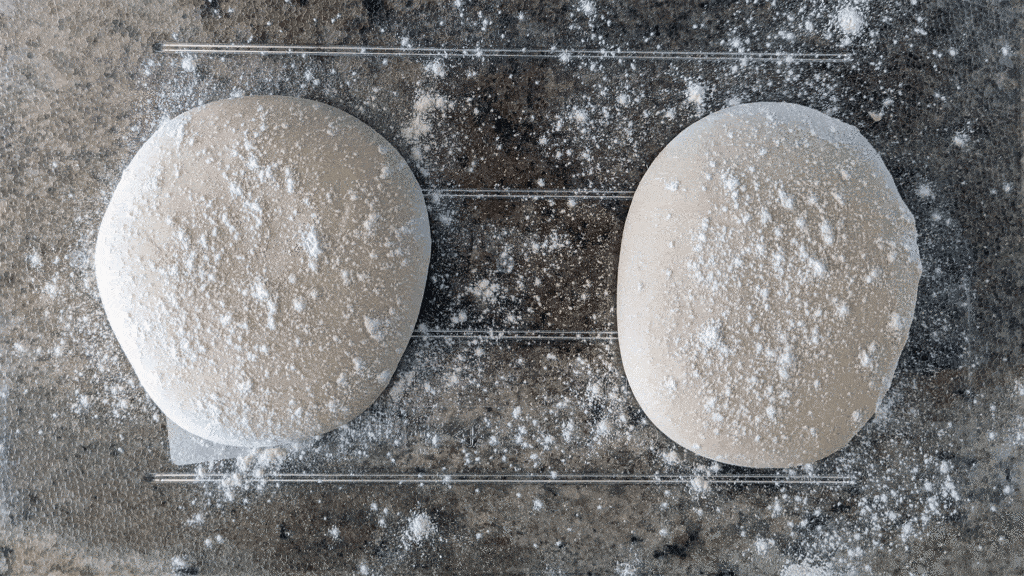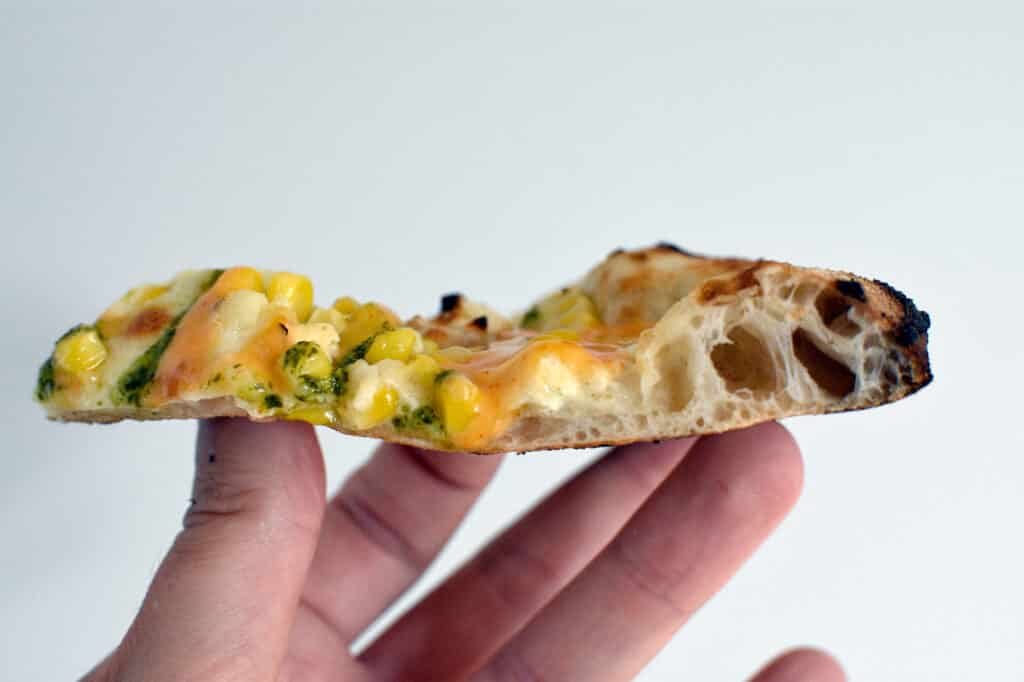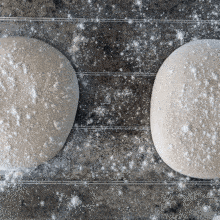If you have ever made a pizza from scratch, you know all the love and care that goes into it. Hardcore home pizza makers know that a pizza oven is essential to get the perfect crust and mouthfeel. Luckily, Ooni and their team of dope engineers developed a more affordable option, which makes attainable pizza ovens for ‘za lovers everywhere. If you have a new Ooni pizza oven and aren’t sure where to start your pizza making, use this Ooni Pizza Dough recipe for the perfect beginner pizza to make in your new oven. There are some trials and tribulations surrounding cooking in a pizza oven for the first time, so I’ll walk you through everything you need to know to ease your learning curve (there will be one).
Best Dough for a Pizza Oven
There can be a bit of a learning curve when first using a pizza oven. First, pizza ovens get very hot. Traditionally, pizza requires a very high temperature to quickly cook the crust, melt the cheese, and warm the ingredients. It can get tricky when you use meats, especially raw meat such as dollops of sausage right on top of the pie. You want everything to cook thoroughly, but not burn or char too much.
A standard pizza oven temperature for Neapolitan dough, for example, reaches up to 950 degrees F! That is much hotter than any standard kitchen oven can reach. Neapolitan dough is the best style of dough to cook in a pizza oven because of the extremely high temperature required, so you will need “00 flour”. Take a quick look at our guide to pizza flours.
That said, any type of dough can be cooked inside a pizza oven. Depending on the style and thickness of your dough, the temperature and cook time will fluctuate. The dough we recommend today is a cold-fermented Neapolitan dough. Cold fermenting is an incredibly easy way to develop more oxygen within the gluten structure without over-proofing the dough.
Why Neapolitan?
The Neapolitan dough is meant to cook inside a very hot pizza oven. The oven is so hot that it only takes about 90 seconds to fully cook this type of pizza. When cooking cold-fermented dough in a hot pizza oven, the crust has browned and blackened spots that happen from the sheer amount of heat blasting the pizza upon entry. This is a phenomenon known as “leoparding” and is a great indication that you are making the dough correctly.

Keep this in mind anytime you visit a restaurant or make your own Neapolitan pizza. Always check the underside of the dough to ensure the leoparding is present. If not, the restaurant may not use Neapolitan dough, a screaming-hot oven, or both.
Items Needed for Ooni-Made Pizzas
Aside from the actual pizza oven and the basic ingredients, there are a few more items you may need for home pizza making. These items will ensure your cooking process runs smoothly without any hiccups. Some of these items may even come with the purchase of your Ooni oven!
- Semolina: Great flour to help prevent sticking and gives the bottom of the pizza a nice texture
- 00 flour: Caputo Blue is the best. King Arthur or Cento Anna work as well.
- Bamboo pizza peel: metal can be used, but can be a lot more tricky for newbies; you will likely need more flour on the peel)
- Pizza turner: a peel can be used in a pinch, but I highly suggest purchasing a proper turner. It’s like a mini peel with a long handle. Any Amazon one works fine; I paid up $60 for the Gozney one and it’s severely overpriced.
- Pizza cutter
- Proofing container: A few Tupperware bowls with lids or plastic wrap work, but if you plan on upping your game consider investing in a commercial polycarbonate proofing box.
Common Dough Problems with Ooni Ovens
Sure, anyone has the ability to fudge a recipe, but there are some pretty specific problems that can arise when making a pizza in a pizza oven for the first time. With time and practice comes more confidence and abilities, so be sure to start slow. You can always venture outside of your comfort zone once you get more comfortable.

Sticking to the Peel
We specifically recommend a bamboo pizza peel for launching pizzas. They allow for less sticking when working with the raw pizza dough when compared to a metal pizza peel. It can be really disappointing when you spend much time and care making a beautiful pizza on your peel, only for it to smush and not release when adding it to the hot oven (we have a pizza peel guide here with some more tips). With that said, metal pizza peels still work great for retrieving pizza since they are thinner; however, I often find myself just using the pizza turner to retrieve it.
In either case, you can use a mixture of half semolina and half 00 flour to dust on your peel before adding the pizza. Once you place the dough on the peel, be sure to give it a little shimmy to move it around a bit. Doing so helps prevent it from sticking onto the peel.
If you STILL find the dough sticking to the peel even after using bamboo and dusting it, you can also drop your dough ball into a bowl of 50/50 semolina and 00 flour to coat both sides before stretching the dough. This is extra insurance that your pizza will release and cook beautifully in your pizza oven.
Fermentation Issues
When fermenting dough, it can turn out to be over-fermented, under-fermented, or just right. An overly fermented dough will have risen too long, causing a very stretchy and airy texture that is no longer pleasant. It can also bring out some funky flavors and aromas that you do not want in your pizza.
Alternatively, you can under-proof your dough, leading to a dense and chewy texture that you wouldn’t normally associate with Neapolitan pizza in addition to it being a bear to stretch out. Usually, a method of 24-hour cold fermentation is the sweet spot for just enough fermentation for flavor and texture, with a lot less variables to cause over-proofing (the ambient temperature and humidity in your house).
Dense Crust
The staple of Neapolitan pizza is the crust. Whether you’re the type who wants leoparding on the crust or not, everyone can agree that Neapolitan pizza crust should be crispy on the outside but beautifully light and airy on the inside. This is achieved by active fermentation in the dough which causes oxygen to release, resulting in nice little pockets of air. This dough recipe will achieve that, but if you still struggle to reach a puffy crust then it very likely has to do with your stretching technique. Check out a few videos on Youtube for a perfect method, which should start with lightly pressing your fingers from the center of the dough and making your way outwards towards the crust. The goal is to flatten and stretch the pizza dough while pushing all of the oxygen to the crust.
Uneven Cooking or Burning
Uneven cooking causes one side of your dough to be perfectly cooked while the other side is raw. Pizza ovens, such as Ooni, have great heat distribution for a perfectly even cook. This usually happens in kitchen ovens or lower-quality pizza ovens. You may have seen pizza makers turn the pizzas during the cooking process to ensure a perfectly cooked result. This is absolutely necessary when cooking with Ooni ovens.

Different Fermentation Methods
Since we prefer a cold-fermented dough, let’s discuss all fermentation methods in pizza dough making.
Standard: Standard fermentation allows for yeast to rise over the course of a few hours in pizza dough. This can take anywhere from 2-24 hours, depending on your specific recipe. These recipes typically use more yeast which can be noticeable in the taste of the dough.
Cold Ferment: Cold ferment typically happens in the refrigerator. Less yeast is used, otherwise, the dough would grow too much in size by the time it’s ready for use. By using less yeast and a longer fermentation, you develop great flavors.
Biga (100% Biga): This is a type of pre-fermentation commonly used in Italian bread-making. It is used as a starter dough, similar to sourdough making, which gives lots of great flavor to the dough and can result in seriously impressive airy crusts.
Poolish: A room-temperature pre-fermentation technique that uses half hydration and half flour with a bit of yeast added. This is very similar to the Biga in that it’s a pre-fermentation, however Poolish has a lot more water added while Biga is more on the dry side. Poolish usually ferments for 12-16 hours before making the final dough.
I strongly recommend learning the cold fermentation technique (recipe below) before diving into Biga and Poolish.
Making the Best Dough for Your Pizza Oven
Your new pizza oven deserves a lot of use. After all, more practice equals more pizza! Stick with a cold-fermentation dough to really maximize the abilities of your new Ooni. Dust your bamboo pizza peel with 00 flour and semolina to ensure no sticking. After all is said and done, enjoy your homemade pizza! Now, let’s get into the recipe.

The No-Fail Ooni Pizza Dough Recipe
Equipment
Ingredients
- 500 g 00 flour Caputo "Pizzeria" is the ideal choice.
- 2 g Instant Dry Yeast Avoid the packets in the grocery store (they'll work in a pinch, but don't get the "pizza crust" one). I really like SAF Instant or Caputo yeast.
- 300 g Water Lukewarm to jumpstart the yeast
- 12 g Salt
Instructions
Mix
- Heat the water in the microwave for 30 seconds; this should result in 80-90F water.
- If you're using Fresh or Active Dry Yeast, mix the yeast into the water and let sit for 2 minutes. If you're using Instant Dry Yeast (IDY), proceed to the next step. Note: Caputo yeast is labeled as Active Dry yeast, but does not need to be activated in water (works as IDY).
- Meanwhile, in the bowl of a stand mixer (turned off!), mix together flour, yeast (if using IDY), and salt by hand. Fit the mixer with a dough hook and turn on medium. Slowly add water and mix until smooth and elastic, scraping down the flour on the sides with a spatula as needed, 5-8 minutes.
Rest
- Remove dough from bowl and briefly knead by hand to form a taut ball. Place on counter, cover it with the bowl, and allow to rest for 20 minutes.
Bulk Ferment
- Divide dough and shape into 3 balls. Place in a lightly oiled air-tight container with lid or bowl with plastic wrap. Ferment at room temperature (~70F) for 1 hour.
Cold Ferment
- Place in refrigerator overnight, or up to 48 hours. Remove the container from the fridge 3 hours before planning to cook, giving the dough time to come to room temperature.
Stretching Dough
- Mix equal parts 00 flour and semolina flour in a large bowl (just 00 flour will work as well but the addition of semolina helps prevent sticking when launching). Drop a dough ball into the flour to lightly coat both sides. On a lightly floured surface, using your fingers and starting from the center of the dough, begin stretching outward. The goal is to push any oxygen in the dough outwards toward the crust. Continue stretching until 12". Using a lightly floured bamboo peel, launch away into your 800-900F Ooni pizza oven!


